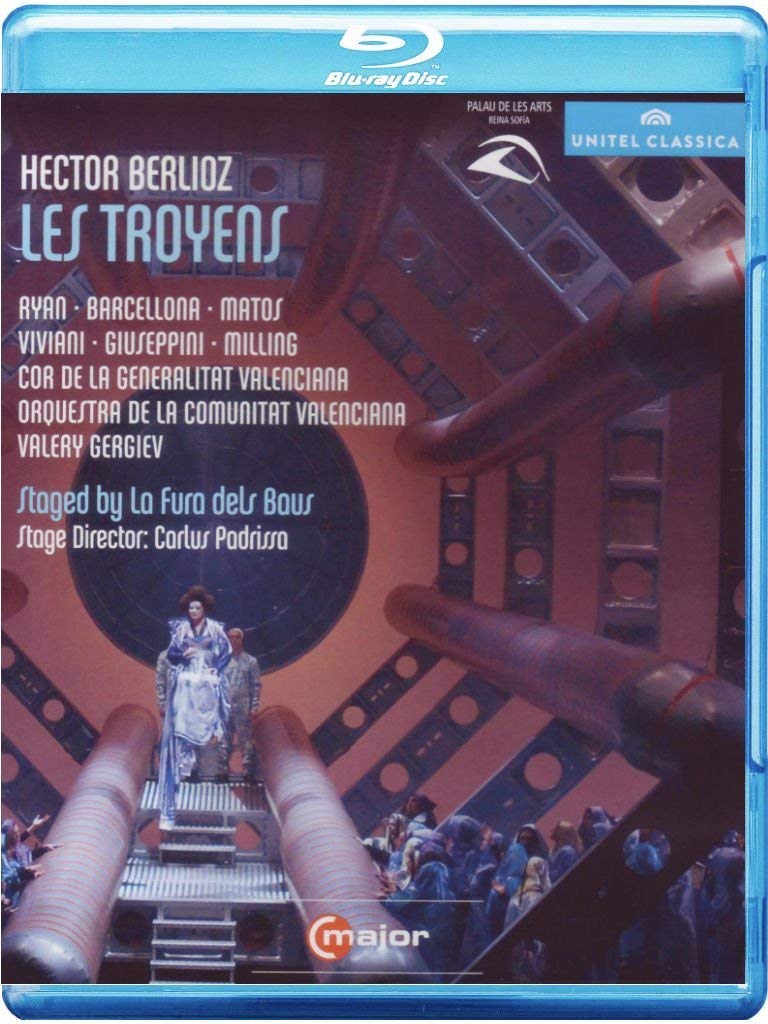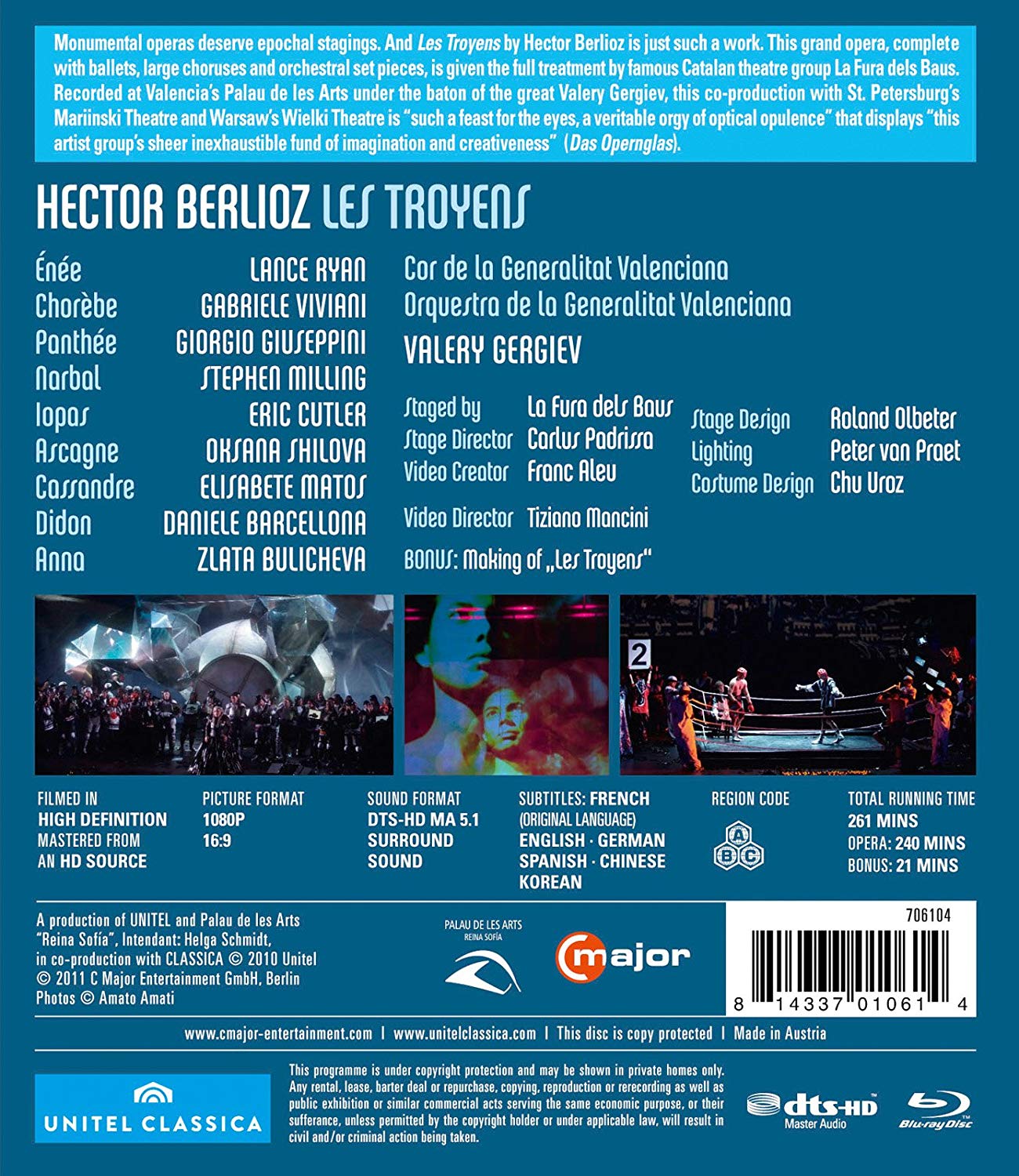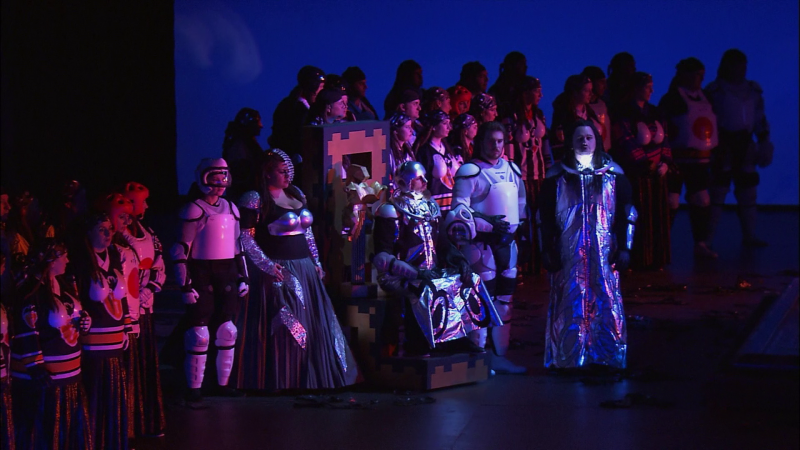

Berlioz Les Troyens opera to libretto by the composer. Directed 2009 by Carlus Padrissa at the Palau de les Arts "Reina Sofía" in Valencia with staging by La Fura dels Baus. Stars Lance Ryan (Énée), Gabriele Viviani (Chorèbe), Giorgio Giuseppini (Panthée), Stephen Milling (Narbal), Eric Cutler (Iopas), Oksana Shilova (Ascagne), Elisabete Matos (Cassandre), Daniela Barcellona (Didon), Zlata Bulicheva (Anna), Dmitri Voropaev (Hylas), Askar Abdrazakov (Priam), Tomeu Bibiloni (Un chef gret), Yuri Vorobiov (L'ombre d'Hector), Javier Agulló (Helenus), Yuri Vorobiov and Vincent Pavesi (Deux Sentinelles Troyennes), Bonifaci Carrillo (Un Prêtre de Pluton), Dolores Lahuerta (Polyxèna), María Luisa Corbacho (Hécuba), Pepa Juan (Andromaque), and Darío March (Astyanax). Stars ballet dancers Tatiana Tkachenko, Elena Yevseyeva, Anton Pimonov, and Alexei Timofeyev of the Mariinsky Theatre, with choreography by Emil Faski. Also stars mimes and dancers Manuel Alcaide, Joaquín Bello, Pablo Bosch, Jordi Cano, Cristina Carrión, María Casasempere, María José Cases, Juan José Dalmau, Blanca Diago, Almudena Mahiques, Aycha Naffaa, Roseta Plasencia, Diego Ramírez, María Jesús Sánchez, Juan Carlos Serrano, José Luis Soria, and Miguel Ángel Sweeney. Valery Gergiev conducts the Orquestra de la Comunitat Valensiana and the Cor de la Generalitat Valenciana (Chorus Master Francesc Perales). Stage music provided by Fundación Desarroya (Director Ricardo Casero). Stage design by Roland Olbeter; video creation by Franc Aleu; lighting design by Peter Van Praet; costume design by Chu Uroz; choreography by María Jesús Sánchez. Directed for TV by Tiziano Mancini. Sung in French. Released 2011, disc has 5.1 dts-HD Master Audio sound. Grade: D+
The Fura dels Baus treatment here is typical in that the libretto is followed quite faithfully with few cuts or reorganization of content. But anything goes with the mise-en-scène: wildly original video projections are used together with bizarre costumes, set, and props to challenge and startle the viewer and often to get across the director's philosophical or political take on the work. Is this approach lamentable artistic high-jacking or commendable updating and re-purposing?
Since the tale of the Trojans goes back to the dawn of human history and the first Western literature, it's almost predictable that Carlos Podrissa will set the opera in the distant future and load it up with high-tech. The time frame is all time, which gives Carlos maximum freedom. Would you be interested in this? Maybe the screenshots below will help you decide. I've related the basics of the Les Troyens story in two reviews of traditional productions of the opera. In this review, I'll skip the story line and focus on the mise-en-scène.
We open with the Trojans outside the city walls dressed like ice-hockey players at a Japanese paint-ball convention. Berlioz used on-stage musicians—ours even have instruments to be invented in the future:
Here's Chorèbe (Gabriele Viviani) with a Cassandre (Elisabete Matos) old enough to be his grandmother (she's in a wheelchair):
The Royals. Priam (Askar Abdrazakov) is seated. To his right stands Queen Hécuba (María Luisa Corbacho) with a perverse crown that runs down her nose. The girl in the white helmet is (I think) Polyxèna (Dolores Lahuerta). Chorèbe is just a future in-law, but he's standing at Priam's left:
Andromaque (Pepa Juan) and Astyanax (Darío Marchand). Each member of court passing in review puts a votive candle on an alter. The candles from Andromaque and Astyanax arrive on a remote-controlled child's car toy that drives crazily around the procession runway:
The appearance of the Trojan horse is an astonishing scene of a slightly out-of-focus object transforming itself in real time in a manner that the spectator's brain cannot comfortably interpret. Here are 3 shots from the horse scene:
The horse turns out to be the "Fat Man," the atom bomb dropped on Nagasaki. (The real Fat Man was a bit smaller than this and had neat tail-fins.) I get it: the Trojan horse was a surprise that brought hidden dangers with it, and so was the Fat Man:
Padrissa loves to hang singers in the air: here is L'ombre d'Hector or Hector's Ghost (Yuri Vorobiov) singing upside down to Énée (Lance Ryan):
Polyxèna for sure (different costume from earlier, I think):
Mass suicide of the Trojan women behind a shower curtain:
The new Queendom of Carthage:
Didon descends on a swing:
The worst wig ever. There's a 4th "Minnie Mouse" orb on the back:
The duet of Didon and her sister Anna (Zlata Bulichev)
Énée in all his glory presents himself to Didon:
The whites in Africa ally themselves against the blacks. From left to right: Narbal (Stephen Milling), Anna, Didon, Énée's son Ascagne (Oksana Shilova), and Énée:
Didon and Énée push back the blacks, and now there's time to relax. The Royal Hunt and Storm scene features a new breed of hunting dog:
Here are some entertainers at Anna's party for Didon:
For me, the best scene in the entire opera shows the sparkling talents of 4 ballet dancers Gergiev brought with him from the Mariinsky Theatre to perform at Anna's party for Didon. Here we see Tatiana Tkachenko and Elena Yevseyeva (don't know which one is which). Sorry about all that red lighting:
Red is the color for passion, so the stage stays red for the love music of Didon and Énée, who perform hanging from wires while dressed in spacesuits:
Yes, this guy in this spacesuit is the sailor Hylas (Dmitri Voropaev), who opens Act 5 singing about how homesick he is. He's usually presented in the crows nest of a ship, but here it's no surprise to see him in space. While he sings, the world turns beneath him and you see the continents on parade:
Didon finds out that Énée is jilting her:
The funeral pyre made of laptops. A neat touch: Didon is wearing Helen's famous golden veil, one of the gifts Énée made to Didon when he first arrived at Carthage:
Had enough? Let's sum up. The orchestra and chorus were good and well recorded. All the major singers seem rattled by the incessant distractions of the directing and mostly intent on just getting it over. Some of the singers with modest roles (like Narlbal) are better. I suspect the French diction is not all that great. The ensemble singing seems harsh throughout: this is sad because the many ensembles are me the strongest element of the traditional presentations we have of Les Troyens.
This production has a lot of video projections. They may have looked fine in the theater live. But the videos seem washed-out and dreary in my HT (and few or none of them could be seen well enough to make screenshots). I can see that Padrissa makes some clever observations with his eccentric designs. But I think they are more distracting than helpful in telling Virgil's story.
So I wind up with a D grade. Still I admit there may well be fans who will be delighted with Padrissa's production. These fans would have an interest the following: (1) the fine arts, (2) HD TV with good sound, (3) grand opera, (4) science fiction, and (5) fantasy literature. To encourage these folks I move my grade up to D+
OR




























